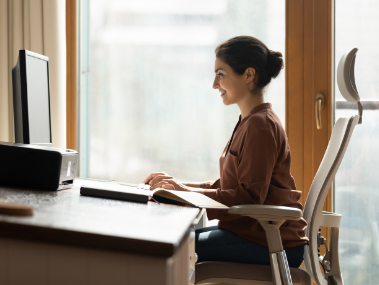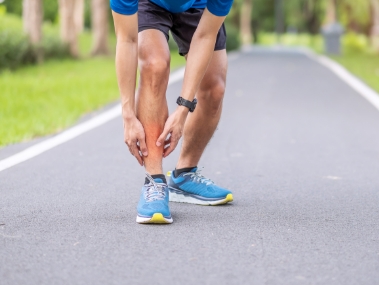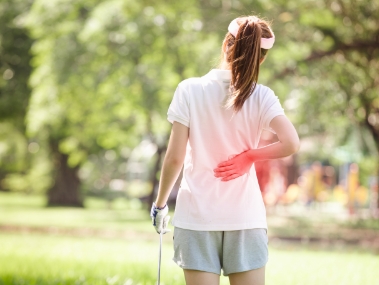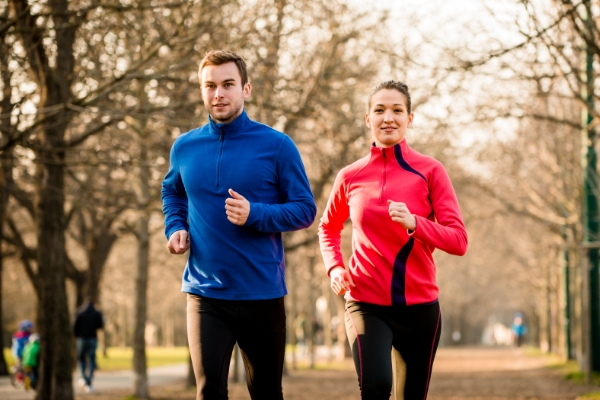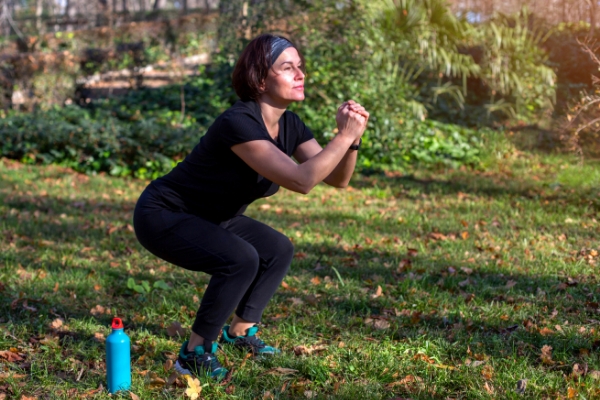We’re here to help you get well and stay well.
Find physiotherapy, massage, chiropractic care or acupuncture near you.
Find a Clinic
Virtual Care
Receive care from the comfort of your home
We continue to offer a range of services through Virtual Care, including Physiotherapy, Chiropractic Care, Occupational Therapy, Hand Therapy and more. Using secure, video conference technology, you can connect one-on-one with a pt Health clinician from the comfort of your own home. Learn more

Latest Blogs
November 24, 2025Pain / PhysiotherapyWhile the snow may look beautiful, it can come with an increased risk of injury for the many Canadians who shovel each year. From twisting the body to trying to move too much all at one time, strains and sprains from snow shoveling can affect daily activities.
Check out these tips to help reduce the risk of injury while you shovel snow this winter:
1. Use your whole body and not just your back.
Get into a squat position, by bending at the knees. Engage your core and hinge at the hips. Lift snow with your legs by straightening your knees to push your body up. Taking this approach can improve your shoveling safety.
2. Clear the snow before it builds.
Shoveling frequently on snowy days can help prevent build up. Snow that is walked over or frozen is significantly heavier to lift and can increase the risk of injury. Try to shovel every few hours during snowfall to help ensure the show you lift is lighter and easier to move.
3. Lift small amounts of snow at a time.
Shoveling can be a strenuous activity. Lifting small amounts of snow reduces the weight of the load, making the activity easier and less likely to cause an injury.
4. Take frequent breaks.
To help you not tire out and risk an injury, consider taking breaks as you shovel. Setting a timer for shoveling and breaks can look as easy as 10 minutes of work and a 5-minute rest or stretch break.
5. Ask and offer help.
Rally up the kids or accept the offer from a helpful neighbour when shoveling snow. This can help take the load off from any one person and encourage and strengthen community.
Snow shoveling may not be a safe activity for everyone. For those with advanced age and/or health conditions such as arthritis, cardiovascular issues, or even a current injury, speak to a health professional before undertaking strenuous activity.
If you do experience pain or discomfort while or after shoveling, take a break immediately.
To schedule an appointment, contact a pt Health clinic near you or book an appointment online.
This blog originally appeared on Lifemark.ca. [...]
October 29, 2025Injury Prevention / Occupational Therapy / PhysiotherapyAs the leaves fall and the weather cools, many of us jump into yard work. Whether you’re hauling patio furniture, raking leaves, or trimming branches, movements with excessive stretching, lifting, pulling or pushing, twisting and turning, can lead to overexertion and injury.
The good news? By taking a few precautions you can help avoid injuries during your autumn clean up. Check out these 7 key tips to keep you safe this fall.
7 tips to prevent injury while cleaning the yard this fall
1. Have a plan (Rome wasn’t built in a day!)
Take some time to plan your projects over several days or weekends.
Set goals. Know your limits. Be realistic about what you can accomplish.
In the house, be methodical: go room by room.
Pace yourself! Pick a good stopping point and start working again another day. You are at greater risk of injury when you are in a hurry to get things done and “overdo it.”
Use the alarm on your smartphone to remind yourself to take breaks every 20 minutes.
Whenever possible, enlist help and assign tasks.
2.Set up
Gather all the tools or equipment you may need before you get started.
Wear loose, lightweight clothes and closed-toe shoes.
When indoors, ensure good lighting especially in halls and stairwells.
When outside, open doors and gates in advance; clear steps and walkways.
Have a bottle of water to stay hydrated.
3.Check equipment and use the proper tools
Use a step-stool or ladder and ensure it is secured properly and safe to use. DO NOT over-reach.
Ensure power tools and other equipment are safe to use (e.g. there should be no exposed wires).
Choose the proper tool for the task at hand. The tool should feel comfortable and natural to you when in use.
Telescopic handles may require less energy and keep your body in proper alignment.
Well-fitting gloves with good grip. Loose-fitting or cloth gloves will decrease coordination and increase the grip strength required causing hand and arm fatigue.
4.Stretch before and during the task
Warm up before you start by gently stretching. This prevents strain and fatigue in the most vulnerable muscles in the neck, shoulders, buttocks, thigh and lower leg. It also increases circulation in the muscles, reducing muscle spasm and stiffness.
Avoid repetitive movements and change your body position frequently to avoid overwhelming muscles.
5.Get close with your shovel, rake and broom
Hug your shovel, rake and broom! Frequently! This rests the back, relaxes back muscles and relieves muscle strain.
Hold equipment close to your body. This reduces strain on joints, upper back and shoulder muscles – and it gives your back a break!
Use your whole body (not just your back and arms) when you sweep, mop or vacuum.
6.Lift and carry with your legs and NOT your back
As you lift, engage your core by pushing your belly button in and down, sinking your tailbone, bend your knees and push through your feet into the ground.
Keep the load as close to your body as possible.
Make two trips instead of “overloading” your back. For example, transfer water using small containers instead of lifting heavy buckets.
If an item is too big to move, ask for help even if it is “inconvenient.”
7.Don’t bend and avoid twisting the body
Keep your back straight and avoid twisting: turn your body so that you are facing the object/area you are working on or when lifting and carrying.
When working close to the ground, kneel with one knee, not both.
Avoid repetitive arm movements such as when cleaning floors: keep the vacuum (or mop) at waist height and close to the front center part of your body. Place both hands on the handle and push the vacuum in front of you while walking in a long line, then pull back using the same motion. Never push and pull in short strokes.
When done safely, fall cleaning can provide a good workout with digging, raking, sweeping!
To schedule an appointment, contact a pt Health clinic near you or book an appointment online.
This blog originally appeared on Lifemark.ca [...]
October 24, 2025Back pain / Ergonomics / Neck pain / Occupational Therapy / workplace-wellnessSetting up your workstation can help prevent injuries. Ergonomics helps you reduce the physical demands and risks placed on your body in any space. With these tools, you can easily arrange any workstation to prevent pain and reduce injury, whether you work from home, the office, or even on your feet.
What is ergonomics?
This applied science of ergonomics is concerned with designing and arranging things people use so that the people interact with them most efficiently (Merriam-Webster). An ergonomic workspace is important for reducing the repetitive and inefficient movements that lead to muscle fatigue, sprains/strains, joint and bone injury. Examples of improper ergonomics include:
Repetitive or prolonged postures/movements
Working too long in the same position
Bending, twisting, lifting in awkward manner
Improper workstation set-up
4 tips to set up your workstation
Be proactive and check out these 4 tips to ergonomically set up your workstation.
1.Reduce risk of shoulder, elbow, and wrist strain
Start by sitting at your desk and placing your hands on the keyboard
Keep your elbows bent at approximately a 90-degree angle, you can adjust your chair height to achieve this
Keep your wrists in a neutral position
2.Prevent neck strain
Keep your eyes level with the top portion of the screen
Tilt the top of the monitor away from you
Place the monitor or screen about arms-length away
3.Avoid low back pain
Support your entire back with a sturdy comfortable chair
Keep your hips and knees bent at approximately 90-degrees while sitting
Keep most used items within reach
Keep chair close to the desk
4.Ergonomically arrange your environment
Reduce/eliminate glare from screens to limit eye strain and set up lighting that is not directly on the monitor
Ensure adequate leg clearance under or around your workstation
Your health matters! Remember to minimize prolonged or poor postures by taking scheduled breaks to move, stretch, or even change your position.
Try these additional tips to strengthen your posture, or ask a ptHealth clinician how you can improve your workstation ergonomics today!
To schedule an appointment, contact a pt Health clinic near you or book an appointment online.
This blog originally appeared on Lifemark.ca [...]
August 21, 2025Exercises / Sports PhysiotherapyNote: The shin pain exercises and/or stretches in this blog are not intended to replace the advice of your physiotherapist. Starting a new exercise, stretch, movement, or activity may result in some expected stiffness and soreness. If you are unsure, please speak to your physiotherapist before attempting any of the suggestions below.
Have you ever experienced shin pain? Commonly referred to as shin splints, this pain can range from a dull ache to a sharp, razor-like sensation in the shinbone (tiba). The pain often gets worse with exercise and subsides after rest. When left untreated, it can become more persistent and may even occur at rest.
Shin pain is often called medial tibial stress syndrome, which is when the muscles on the inside of the shin that attach to the lower leg bone start to get overloaded. With activity or exercise, they start to pull and irritate the attachment of the muscle and tendon to the bone, creating pain.
Shin pain is not just a runner’s injury. It can affect anyone who enjoys walking or other physical, high-impact activities. Whether it’s from overuse, wearing improper footwear, or muscle imbalances, shin splints can make even the simplest movements feel difficult.
See how these 3 exercises target the area by building strength, releasing tension, and stretching the muscles of and around your shin to help you move with ease. Let’s dive in!
3 moves to reduce shin pain:
1. Toe Raises (Seated or Standing)
How it helps: Strengthens the muscles at the front of the shin.
How to do it:
Sit up in a chair with your feet flat on the ground.
Lift your toes up toward your knees, keeping your heels on the ground, and then slowly lower your toes back to the ground.
Repeat 5 times.
Progress to standing toe raises. You should feel this in the muscles in front of your shin.Optional: If you need an extra challenge, consider adding weight on your toes.
2. Massage stick for muscle release
How it helps: The massage stick helps to release tension and trigger points (sore points of tension) and can be used before or after exercise.
How to do it:
Try to keep the muscle in a relaxed position.
Roll gently up and down for about one minute per side.
If you find a sore spot, stay on that area for a few more seconds until the muscle is less tense.
Tip: Maintain gentle pressure as excessive use can cause muscle soreness.
3. Seated shin stretch
How it helps: Stretches the front of the lower leg to relieve tightness.
How to do it:
Sit on a chair and cross your injured foot over the opposite knee.
With your hand, gently bend the foot down and turn it outwards (toward the little toe) until you feel a stretch at the top of the foot.
Hold this position and relax for 30 seconds
By focusing on strengthening, releasing tightness, and stretching the muscles in front of the shin, you can help begin to reduce shin pain and return to activities you love.
To see these exercises in action, check out the video below!
To schedule an appointment, contact a pt Health clinic near you or book an appointment online.
This blog originally appeared on Lifemark.ca and was written by Karen Tyssen. [...]
August 19, 2025Exercises / Sports PhysiotherapyWith warmer weather here, many Canadians are ready to head out to their favourite golf course and enjoy the game they love. But what if you’re experiencing pain or discomfort in your golf swing?
While golf is a low impact game, it’s very common for golfers to develop injuries, as nearly 50% of all amateur golfers report at least one injury per year. Those rates can increase with individuals who play more frequently or have subpar biomechanics.
Physiotherapy can improve your golf game. Not only can a physiotherapist help manage several types of injuries that may be limiting your performance, they can also create an exercise program adapted to your needs to potentially enhance your skills.
Strength training and plyometrics
Targeting the mobility, stability and strength of the joints and musculature in the trunk, hips and shoulders are pivotal to improving your golf swing. Studies have shown that strength training and plyometrics (explosive exercises) focused on these areas can improve peak speed of leading arms and hand in a golf swing, club head speed, and ball distance.
One exercise you can look into is the rotational medicine ball throw, which targets the desired joints and muscles while mimicking the explosive rotational component of a golf swing. This transfers perfectly into your golf game!
Recent evidence has shown that improving grip strength with the use of fat grips can also benefit your golf game, as performing resistance training with fat grips around the bar handles can improve ball speed, carry, driving distance and left-hand grip strength.
Improving forearm and wrist strength also wouldn’t hurt your golf swing because the energy transfer that originates from your hips and torso must pass through your forearms and wrists on the way to the club head.
Physiotherapy for golf injuries
Golf requires strength, flexibility, explosive power, endurance and athletic ability. Over time, these forces can cause different injuries, which generally affect areas such as the shoulders, elbows, wrists, hips and lower back. The impact of golf on your body can vary greatly depending on your swing type, posture, fitness level and other factors.
To schedule an appointment, contact a pt Health clinic near you or book an appointment online.
*This article was originally published by Active Physio Works, which is part of the Lifemark family [...]
June 25, 2025Vestibular RehabilitationSummertime, and the living is not so easy … if you have a vestibular disorder
Summertime conjures up images of getting outside, traveling, going to social gatherings, having a few drinks on the patio. This sounds great and relaxing to most people – but if you have a vestibular disorder, these activities can be a real challenge and can make symptoms worse.
Dizziness symptoms and the great outdoors Those with vestibular problems can’t use the information from their inner ear(s) about balance and orientation as well as they used to. Therefore, they are typically more dependent on the position information they get from their feet and ankles than the rest of us. Walking on surfaces that are not hard and flat spells trouble, so walking on the soft grass, sand, or unpaved trails can create unsteadiness and fear of falling.
Balance challenges on a plane or boat How about travelling? Being on a plane or boat can be very challenging for people with vestibular problems, again because the information they are getting from the muscles and joints in their bodies is no longer the same as what they get when on solid ground.
These forms of travel also create a mismatch in the balance system, because when you look around inside the plane or boat you appear to be stationary, yet your body and your inner ears sense that there is some motion. Usually the inner ear/vestibular system would step in to sort out this conflict, but if that isn’t working properly, people can start to feel quite disoriented and unwell. Looking out of the plane or boat, rather than at items inside, can be helpful so that your eyes can see that there is some movement taking place, and can then ‘agree’ with your body and inner ears.
Vestibular disorders and visual cues How about a relaxing drive to the lake, or a nice park? Driving in a car can create the same scenario as being in a plane or boat, especially if sitting in the back seat. Those with vestibular disorders are overly dependent on the information about orientation that they get from vision. When that is the case, people can get quite stirred up by visual stimulation: the sunlight flickering through the trees, the motion of other vehicles around them, all the scenery going by. And once you get to the lake, even just watching the movement of the water can be quite disorienting and disturbing.
How about a social activity at home, with friends and family? Sounds promising, but at social gatherings where there is the visual stimulation of people milling about, a lot of standing instead of sitting, head-turning as you talk to this person and that, this can be a provoking option as well. Add in spongy flip-flops or those great strappy shoes with a bit of a heel, and a few drinks, and those with vestibular disorders often find their symptoms flare up.
Education, pacing, strategic choices and appropriate treatment – Despite all this – you don’t need to give up on summer enjoyment! With education, pacing, strategic choices and appropriate treatment, those with vestibular disorders can reduce and manage their symptoms and enjoy life! See: http://vestibular.org/living-vestibular-disorder/everyday-challenges#travel for tips.
Hopefully the scenarios described above can help those without these disorders appreciate the hidden challenges that those with vestibular problems are trying to work around, and offer their understanding and assistance.
Click here to watch a series of videos on the vestibular system, the most common causes of vertigo, dizziness and balance issues, and how to find relief: http://bit.ly/2A0V3k1
To schedule an appointment, contact a pt Health clinic near you or book an appointment online.
This blog originally appeared on Lifemark.ca and was written by Sheelah Woodhouse. [...]
June 20, 2025Mental HealthResearch shows that individuals who identify as lesbian, gay, bisexual, transgender, queer, two spirit, and those who don’t identify as CIS-gendered or heterosexual (2SLGBTQIA+) experience discrimination that is detrimental to their mental health. Understanding the forces that work to oppress individuals of the 2SLGBTQIA+ community is essential in becoming an ally and promoting social equity. Read on to learn more!
What is the minority stress theory?
The minority stress theory explains the conflict between a minority and dominant group within a social context. Those who identify as a minority on the basis of age, sex, gender, race or religion may experience stress that is unique to their identity. This conflict may present as racism, sexism, ageism or homophobia as a result of one’s identity straying from dominant and normative social expectations.
Individuals who identify as 2SLGBTQIA+ are one of the populations that experience minority stress on the basis of sexual orientation within a heterosexual dominant society. Research shows that as a result of experiencing forms of oppression, 2SLGBTQIA+ individuals are at a greater risk of substance use, mental health challenges (i.e., anxiety, depression, obsessive-compulsive and post-traumatic stress disorder PTSD, and phobic disorder), risky behaviors as well as suicidality and self-harm.
Minority stress: intersecting identities
Intersectionality explores how different aspects of a person’s identity (i.e., race, class, sex or gender) merge to discriminate and/or disadvantage. Looking at something through an intersectional lens means considering how different aspects of someone’s identity in a social context can work to affect them. The discrimination that someone experiences can be a result of their collective overlapping identity, rather than just one aspect. For example, those who identify as 2SLGBTQIA+ students who also experience a disability are more likely to be bullied and drop out of school than those who are able bodied.
How to be an 2SLGBTQIA+ ally
Do not be afraid to ask – being an 2SLGBTQIA+ ally is about being respectful and asking how you can support individuals and/or the community at large. Here are some ways to be an ally:
Learn to recognize your own personal biases
Remain open-minded even if it may be difficult or uncomfortable for you
Speak with people in the 2SLGBTQIA+ community and listen to their experiences
Use inclusive language to ensure that everyone feels respected
Stand up to those who make offensive comments about 2SLGBTQIA+ individuals and/or community
Intervene safely if you witness negative behaviour by others
Educate yourself through your own research
How is Lifemark working to promote the health and wellbeing of 2SLGBTQIA+ communities?
Improving awareness of the social context that 2SLGBTQIA+ individuals live in
Understanding how internalized discrimination can have an impact on mental health and wellbeing
Conducting equity training to help staff members learn about the various forces of oppression that enforce stereotypes and/or discrimination
Increasing awareness that those who belong to multiple marginalized communities (e.g., those who identify as 2SLGBTQIA+ and Indigenous) may face additional barriers
Educating yourself on the impacts of minority stress can help decrease the health disparities that exist between dominant and minority groups. These communities often face oppression and/or discrimination, leading to inequitable healthcare services. The minority stress theory allows us to have a better understanding of others’ lived experiences and places us in a better position to advocate for more empathetic policies.
Additional resources
Kids Help Phone – Children and youth ages 5-20 can speak with trained counselors at Kids Health Phone (1-800-668-6868).
Lesbian, Gay, Bi & Trans Youthline – The Lesbian, Gay, Bi & Trans Youthline offers free peer support for youth aged 26 and under (1-800-268-9688).
Parents, Friends of Lesbians and Gays (PFLAG) – PFLAG (www.pflagcanada.ca) is a resource for 2SLGBTQIA+ people and their families.
This blog originally appeared on Lifemark.ca and was written by Elise Kopman & Reem Al-Kas, 2nd year OT students at University of Western Ontario. [...]
May 16, 2025Vestibular RehabilitationDid you know that migraines don’t always present with head pain? A migraine can trigger many different sensations depending on the part of the brain that is being affected. Approximately 30% of migraine sufferers experience vestibular migraine, with symptoms of dizziness, vertigo or imbalance during their attacks. Even between attacks, those with vestibular migraine can have slightly decreased balance and sensitivity to head movement and visual stimulation. Vestibular migraine is becoming recognized as one of the most common causes of episodic dizziness. However, because a headache may not be present at all, this diagnosis is often overlooked by the medical community.
Vestibular migraine is diagnosed when:
A person has had at least 5 episodes of vestibular symptoms of moderate or severe intensity, lasting 5 minutes to 72 hours (vestibular symptoms would include things like vertigo, dizziness with head motion, unsteadiness);
At least half of the episodes have one or more of the following: headache, visual disturbance (aura), and intolerance to light or sound;
There is a current or history of migraines; and
Symptoms are not more appropriately explained by another vestibular diagnosis
How are vestibular migraines managed?
Treatment of vestibular migraines is like any other type of migraine – typically a combination of dietary and lifestyle modifications to reduce the occurrence of migraines, and/or medication.
One of the most challenging parts of living with migraine is the unpredictability of when one might occur, but often people have more control than they think. The trigger for a migraine is seldom one thing, so it can be helpful to think of it like a threshold, or a combination of factors that must build up to set off a migraine. For example, people may feel helpless because their migraines can be triggered by changes in the weather which they have no way of controlling. However, by taking steps to reduce factors they can control (eating regularly, staying hydrated, good sleep routine, exercising, etc.), they can increase the threshold for triggering a migraine. If you think the description of this condition sounds like what you are experiencing, here is a link to the diagnostic criteria1 that you can take to your Doctor to discuss.
Vestibular rehabilitation can be helpful for those with vestibular migraine who have mild residual symptoms of imbalance or sensitivity to head movement or visual stimulation between attacks. Vestibular rehabilitation is a proven therapy where specific individualized techniques are used to help the brain to compensate for problems in the vestibular system, or where maneuvers are done to correct mechanical dysfunctions in the vestibular part of the inner ear. Most vestibular therapists are specially trained physiotherapists, and as such, they can check for neck dysfunctions which may also contribute to migraine triggers.
To schedule an appointment, contact a pt Health clinic near you or book an appointment online.
This blog originally appeared on Lifemark.ca and was written by Sheelah Woodhouse. [...]
March 25, 2025PhysiotherapyNote: You should consult a healthcare professional before starting this or any exercise program to make sure the movements are right for your needs.
Outdoor running season has arrived and you’ve done your best to prepare for running season but you’re still worried you will experience low back pain with running. If you find yourself dealing with low back pain while running, it may be attributed to a lack of stability in your core muscles forcing the joints of the spine to take more load. How do we prevent this kind of injury from happening?
A great way to do this is to make sure you prepare and strengthen your core prior to beginning your running program. Your hips also take a significant amount of load during running, so strengthening your glute muscles can help make sure your hips are ready to go.
Your glute (hip/buttock) muscles act to stabilize your pelvis and hips when you are weight bearing. It’s important to ensure these muscles are also ready to support you on your run.
Below, you’ll find some exercises to follow that can get you started on strengthening. Begin by doing these exercises 3 times per week for 2 sets of 10 repetitions and progress to 5 times a week as your muscles start to tolerate more.
Exercises to prepare you for running season
1) Dead bug
Begin laying on your back with your arms and legs facing the sky, slowly move your opposite arm and leg to be flat with the floor while maintaining a body/trunk in a stable position. This exercise is great for runners as it mimics your arms and legs moving in different directions while your core works to stabilize you.
Remember to keep one arm and leg facing the sky and try to limit the amount of side to side movement, try to keep your body aligned by maintaining control.
2) Bird dog
This exercise is another core stabilizer. Begin in a tabletop position and move your opposite arm and leg to be straight and in line with the rest of your body while keeping a neutral spine/back. Similar to dead bug, it can assist with building core strength while your arms and legs move in opposite directions.
This exercise adds the challenge of moving your arms and legs against gravity while also incorporating balance. Remember to only go as high as you can with control. With this exercise it is more important to maintain a stable trunk than it is to get the perfect alignment with your arms and legs.
3) Clam shell
Begin in a side lying position with your legs bent and your feet together. Keep your feet together as you separate your knees and slowly bring them back together. Ensure the movement is slow and controlled. Add a resistance band when you are ready and ensure you control the speed of the movement against the band.
This exercise is great to help strengthen your glute muscles to support your hips and pelvis in weight bearing.
4) Lunge
Begin standing comfortably, step forward with 1 leg and lower yourself down towards the floor, so that both your legs achieve a 90° angle (a near kneeling position). Hold for 2-3 seconds then step back up to standing. Switch legs after each step. Ensure the movement is controlled and try to maintain your balance throughout.
Running is a single leg activity. Therefore, it is great to include single leg exercises into your strengthening routine to prepare your body to support its weight on one leg and build strength.
The above exercises are great to do if you want to get started on building some core and lower body strength. Always remember to breathe when you’re doing exercises and take breaks as needed. As you build more strength, you can increase the frequency of these exercises and sets for an extra challenge.
Check out the next installment of this blog series, where we introduce a running plan to get you help you get started on your running program!
To schedule an appointment, contact a pt Health clinic near you or book an appointment online.
This blog originally appeared on Lifemark.ca and was written by Paola Finizio – a Physiotherapy student at Queen’s University. [...]
March 21, 2025PhysiotherapyYou might think that shin pain happens to runners, but this issue can happen to anyone who has recently intensified their level of physical activity. Shin pain, also known as “shin splints”, is a condition caused by inflammation of the tibialis posterior muscle. This muscle runs along the front and inside of the tibia, or “shin bone”.
How does the tibialis posterior muscle connect to shin pain?
When running or walking, the foot and ankle go through the movements of pronation and supination. In common terms, pronation is flattening of the arch of the foot, which is a necessary movement to provide shock absorption. Supination refers to the arch of the foot lifting up, required to make the foot and ankle stable when pushing off.
The tibialis posterior muscle helps to produce the movement of supination but also helps to brake or decelerate the motion of pronation during walking or running. Several factors can contribute to overuse and inflammation of tibialis posterior:
Worn out footwear – A walking or running shoe helps to provide support for the foot and ankle. When a shoe starts to break down there can be more pronation of the foot and ankle which means the tibialis posterior muscle has to work harder.
Tight calf muscles – When the calf muscles at the back of the lower leg are tight, they limit ankle range of motion and cause an increased amount of foot pronation. This forces the tibialis posterior muscle to work harder to work against this tight muscle group.
Weak hip and core muscles – Foot and ankle pronation results in inward rotation of the lower leg. Muscles higher up the leg also control the amount of inward rotation that occurs at the ankle.
How to treat shin splints yourself at home
If you think you have shin splints, follow these guidelines:
Rest the inflamed tissue by finding an activity that involves less weight bearing through your leg, such as cycling or swimming
Ice the inflamed area for 15-20 minutes, several times per day
Wear shoes indoors to rest and protect the inflamed tissue
If your shoes are between 6-12 months old, consider investing in a new pair
You can also try some stretches and strengthening exercises:
Perform calf stretching exercises to improve ankle range of motion
Perform strengthening exercise for tibialis posterior, such as an ankle inversion with a towel
Perform strengthening exercises for the hip girdle and the core muscles, like a clamshells or squats
When in doubt, seek help from a professional
Most cases of shin splints can be treated with rest, ice and other self-care measures, but you can consult a healthcare professional such as a physiotherapist, chiropodist, or pedorthist to evaluate your condition, assess your gait, and develop a personalized treatment plan for further guidance and intervention as needed.
To schedule an appointment, contact a pt Health clinic near you or book an appointment online.
This blog originally appeared on Lifemark.ca and was written by Meg Smith, MSc, FCAMPT, Physiotherapist. [...]


